|
|
|
Sort Order |
|
|
|
Items / Page
|
|
|
|
|
|
|
| Srl | Item |
| 1 |
ID:
171645
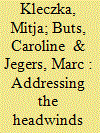

|
|
|
|
|
| Summary/Abstract |
The European arms industry is challenged by several adverse “headwinds.” Fragmentation leads to costly duplications and, in conjunction with stagnating budgets and sharply increasing costs, prevents firms from exploiting economies of scale and learning. This is exacerbated by size differentials vis-a-vis the leading US arms manufacturers and competition from emerging producers. As some “headwinds” are self-enforcing, far-reaching industrial and policy responses are required to improve the industry's outlook. As exports may not indefinitely compensate for low domestic demand, there is an economic imperative for further cross-border collaboration and consolidation. Despite various EU policy initiatives, progresses regarding the European Defence Equipment Market and strengthening the European Defence Technological Industrial Base have been relatively slow. It remains to be seen whether the European Defence Fund will be the proclaimed “game-changer,” raising competitiveness of the European arms industry. At the same time, the UK's withdrawal from the EU adds uncertainties.
|
|
|
|
|
|
|
|
|
|
|
|
|
|
|
|
| 2 |
ID:
132511
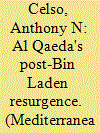

|
|
|
|
|
| Publication |
2014.
|
| Summary/Abstract |
The Barack Obama administration's May 2013 assessment of al Qaeda's weakness and fracturing in the post-bin Laden era has been greeted with indignation by both liberals and conservatives. They believe al Qaeda is stronger than ever in the wake of the Arab Spring. These critics, however, misunderstand the network's dysfunctional direction. Al Qaeda's "resurgence" is likely to lead to its failure. The argument proceeds on four levels: (1) the dramatic growth of the al Qaeda network masks its internal weakness and organizational splintering; (2) the Arab Spring has led to a burst of al Qaeda activism that is likely to undermine its jihadist cause; (3) al Qaeda's fragmentation and its multiple trajectories in the post-9/ 11 era violate bin Laden's original intent and are beyond al Qaeda Central's direction; and (4) the dysfunctional nature of al Qaeda's ideology and its excessive reliance on takfiri violence is paradoxically a source of both persistence and failure.
|
|
|
|
|
|
|
|
|
|
|
|
|
|
|
|
| 3 |
ID:
189357
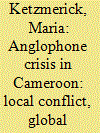

|
|
|
|
|
| Summary/Abstract |
After years of peaceful demonstrations, the Cameroonian Anglophone conflict escalated in 2017. Since the outbreak, over 3,000 people have died and a further thousand Anglophones fled from clashes between state forces and separatist fighters. While activists in the diaspora bid for international support, organizational belonging on the ground changes quickly. The paper investigates the transnationalization of the conflict by looking at the complex set of actors involved. Overall, it is interested in the political sociology of transnational rebel governance. The paper highlights the effects of transnational conflict dynamics on the unity and fragmentation of the self-determination movement and its relation to violence.
|
|
|
|
|
|
|
|
|
|
|
|
|
|
|
|
| 4 |
ID:
144932
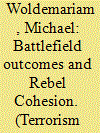

|
|
|
|
|
| Summary/Abstract |
This article uses data from the Eritrean war for independence to refine existing theories of rebel fragmentation. The author argues organizational performance affects the emergence of factional infighting within rebel organizations in unique and novel ways. While battlefield losses increase the likelihood of internal fragmentation, so do battlefield gains. The implication is battlefield stalemates possess unique properties that promote organizational cohesion in war, a relationship this study refers to as “cohesive stalemates.” The article extends an emerging literature on the internal politics of insurgent groups that has linked the coherence of rebel organizations to rebel losses.
|
|
|
|
|
|
|
|
|
|
|
|
|
|
|
|
| 5 |
ID:
177044
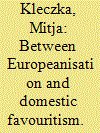

|
|
|
|
|
| Summary/Abstract |
Germany’s export-oriented defence industry, like most other “large” European producers, aims to maintain its “key” capabilities whilst the scope for national approaches narrows further. Given the rising economic and security challenges, it appears likely that Europeanisation will gradually proceed.
|
|
|
|
|
|
|
|
|
|
|
|
|
|
|
|
| 6 |
ID:
159362


|
|
|
|
|
| Summary/Abstract |
After nearly four years of civil war, Libya continues to be described as an ‘ungoverned space’ where the collapse of state institutions reignited tribal, political, religious and ideological tensions. These accounts, however, obscure Libya’s complex subnational governance, and the role of non-state armed groups in shaping the emerging political orders. By contrast, we contend that distinct subnational political orders have emerged in Libya since 2014 in which actors engage in state-making practices driven by local interests. Using empirical evidence to explore the activity of non-state armed groups during the Libyan civil conflict, we highlight that the local conflict environments in eastern, western and southern Libya provide specific incentives that shape the process of armed group splintering and patterns of violence. The findings demonstrate that claims to authority and notions of statehood extend far beyond the state whereby governance relations are negotiated between state and non-state actors. Conflict patterns, (in)stability and the prevailing political order are therefore conditional on the nature of the dominant actor, their strategies and modes of violence within their areas of influence. Through this analysis, the paper provides a more granular understanding of the local political dynamics that drive violence in Libya and civil wars more generally.
|
|
|
|
|
|
|
|
|
|
|
|
|
|
|
|
| 7 |
ID:
132832
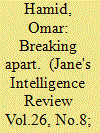

|
|
|
|
|
| Publication |
2014.
|
| Summary/Abstract |
Political and religious militants in Karachi used organized crime to fund their activities, protected by links to political parities and facing a weak security response. Omar Hamid examines the drivers behind the city's increasing fragmentation.
|
|
|
|
|
|
|
|
|
|
|
|
|
|
|
|
| 8 |
ID:
112723
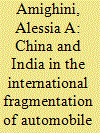

|
|
|
|
|
| Publication |
2012.
|
| Summary/Abstract |
We explore the relative positions of China and India in the international fragmentation of automobile production by analyzing disaggregated trade flows, while distinguishing between final and intermediate goods. The size and composition of trade has significantly moved in favor of trade of components over the last decade, but major differences exist between the two countries; China is a net car importer, while India is a net car exporter. We find evidence of the increasing importance of two-way trade in vertically differentiated goods, indicating that China and India are becoming more active participants in the vertical division of labor in automotive production.
|
|
|
|
|
|
|
|
|
|
|
|
|
|
|
|
| 9 |
ID:
153924
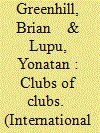

|
|
|
|
|
| Summary/Abstract |
Has international cooperation become fragmented in recent decades? We focus on a specific form of potential fragmentation in the international system: the extent to which the network of intergovernmental organizations (IGOs) consists of distinct clusters of closely cooperating states. IR scholars—including those with an interest in the causes and consequences of membership in IGOs—pay relatively little attention to the structure of the larger IGO network. At the same time, scholars concerned with fragmentation often assume that it has increased without clear measures of this phenomenon. We use the network analytic technique of modularity maximization to show that throughout the post–World War II period, the structure of the IGO network can generally be divided into distinct groups of states on the basis of their shared IGO memberships. Yet we also show that temporal trends indicate that the IGO network has become less fragmented in recent decades, suggesting that cooperation via these organizations has become more global and less regional. Our findings indicate that, at least as far as cooperation through formal organizations is concerned, fragmentation has decreased in recent decades.
|
|
|
|
|
|
|
|
|
|
|
|
|
|
|
|
| 10 |
ID:
173130


|
|
|
|
|
| Summary/Abstract |
To what extent does sexual violence influence rebel group fragmentation? A substantial body of research explores wartime rape as a cohesion-building mechanism following forced recruitment. However, the relationship between sexual violence and broader organizational structural integrity has not been systematically tested. Our study on the effects of sexual violence on rebel group fragmentation provides this test. We argue that sexual violence increases cohesion at the battalion level but increases the risk of fragmentation of the broader organization because lieutenants are more likely to split from organizations if they are confident that their subordinate battalions are cohesive and will follow them. We test this argument on a global sample of 105 rebel organizations active between 1989 and 2014. The results provide robust support for the argument showing sexual violence increases the probability of fragmentation by a factor of six. This presents a crucial contribution to our understanding of sexual violence and rebel group fragmentation.
|
|
|
|
|
|
|
|
|
|
|
|
|
|
|
|
| 11 |
ID:
148620
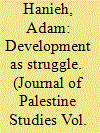

|
|
|
|
|
| Summary/Abstract |
The occupied Palestinian territories (oPt) are a major recipient of global aid flows, ostensibly aimed at improving development outcomes for the Palestinian population. This article presents a critical analysis of the ways that development is being conceived and practiced by major actors in the oPt. By analyzing different conceptions of power, the article examines how dominant approaches to development hide the ongoing reality of Israeli settler colonialism by dehistoricizing Zionism and its project; incorporating the structures of Israeli occupation into official Palestinian development strategy; and promoting an economic perspective that views development as an objective and disinterested process operating above (and outside) power relations. After considering some of the ramifications of current approaches to development, the article concludes with brief remarks on how this critique can help to reframe and articulate an alternative strategy.
|
|
|
|
|
|
|
|
|
|
|
|
|
|
|
|
| 12 |
ID:
120623
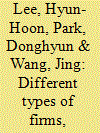

|
|
|
|
|
| Publication |
2013.
|
| Summary/Abstract |
Using highly disaggregated HS 8-digit product-category level data collected by the Chinese Customs Office for 2000 and 2008, we perform an in-depth anatomy of China's imports of manufactured goods. We estimate both the extensive margins - number of products imported per product group or trade partner - and intensive margins - amount of imports per product group or trade partner - of China's imports. Our paper contributes to the literature of firm heterogeneity in international trade in three different ways. First, we distinguish firms into foreign firms and domestic firms, which are further divided into private firms and public firms. Second, we distinguish products into final goods and intermediate goods. Third, we estimate gravity equations from the perspective of dynamics utilizing a dynamic adjustment model. Overall, our analysis yields a number of new stylized facts about China's imports. These, in turn, help us to gain a fuller understanding of China's trade patterns in light of its recent emergence as a globally significant importer.
|
|
|
|
|
|
|
|
|
|
|
|
|
|
|
|
| 13 |
ID:
190064
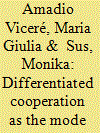

|
|
|
|
|
| Summary/Abstract |
While the standard conceptualization of differentiation in the European Union (EU) focuses on differentiated integration, scholars devote less attention to differentiated cooperation. This article argues, on the contrary, that member states’ engagement in differentiated efforts in EU foreign policy manifest themselves both in the form of differentiated integration and cooperation. It elaborates an original conceptual framework for exploring differentiated cooperation as a mode of governance. Drawing on the articles in this special issue, this introduction maps empirical manifestations of differentiated cooperation in various areas and dimensions of EU foreign policy. The results of the special issue show that differentiated cooperation has mostly manifested itself in informal patterns of cooperation, with the treaty-based mechanisms being limited. As such, the special issue reflects the differentiation and informalization processes occurring not only in the EU, but also in global governance more broadly.
|
|
|
|
|
|
|
|
|
|
|
|
|
|
|
|
| 14 |
ID:
143321
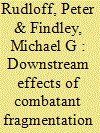

|
|
|
|
|
| Summary/Abstract |
We consider whether the fragmentation of combatants during civil war has downstream effects on the durability of peace following civil wars. We contend that the splintering of combatant groups, a primary manifestation of rebel group fragmentation, produces potential spoiler groups that are neither incidental nor unimportant in the process of civil war resolution. Making connections to the spoiling and credible commitment literatures, we hypothesize that rebel splintering hastens the recurrence of civil wars. Using event history modeling and propensity score matching to analyze two different civil war datasets, we examine whether the occurrence of fragmentation during a civil war influences the length of peace after the civil war. The empirical analysis of fragmentation events during civil wars since World War II offers support for the hypothesis that splintering decreases the duration of post-civil war peace. The results suggest the need to pay closer attention to the dynamics of fragmentation, and particularly how these dynamics lead to future consequences – even when those consequences take place after the war has concluded. For example, governments that attempt to splinter groups or to use existing fragmentations within rebel groups to end a civil war may encourage the unintended consequence of shorter peace duration.
|
|
|
|
|
|
|
|
|
|
|
|
|
|
|
|
| 15 |
ID:
143320


|
|
|
|
|
| Summary/Abstract |
Why are some ethnopolitical movements divided while others are relatively unified? A growing literature examines the consequences of internal divisions in ethnopolitical movements – and shows that it matters for a range of conflict outcomes – yet the mechanisms causing such divisions remain poorly understood. Our argument emphasizes competitive dynamics between states and self-determination movements and between rival factions within these movements as key determinants of fragmentation. Drawing from literatures on social movements, contentious politics, and civil war, we situate our argument vis-à-vis three alternative and complementary sets of explanations based on theories emphasizing transnational dimensions, political institutions, and structural factors within ethnopolitical groups. Using an original dataset, we test hypotheses explaining movement fragmentation over time and use a case study of Punjab in India to identify specific causal mechanisms and missing variables. Our findings show some support for three of these theories, suggesting that ethnopolitical movements divide as a result of complex and interactive processes. But our findings also underscore that central to explaining fragmentation dynamics are factors capturing competitive dynamics, including repression, accommodation of movement demands, the turn to violence, and the dynamic and changing nature of ethnopolitical demands.
|
|
|
|
|
|
|
|
|
|
|
|
|
|
|
|
| 16 |
ID:
154716
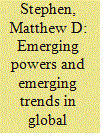

|
|
|
|
|
| Summary/Abstract |
In the 1990s, liberal optimism permeated the study and practice of international politics. International institutions were strengthened and the discourse and practice of global governance consolidated as a new approach to world affairs. Today, new powers are emerging in this institutionalized order. New powers have changed the power relations that underpinned global governance and are also economically, politically, and culturally different from established powers. Against this backdrop, this article investigates the impacts emerging powers are having on global governance. It presents six major trends and outlines their implications for the new global governance currently taking shape. Because new powers are emerging in an already institutionalized order, the emerging global governance order is gradually growing out of the existing one. Emerging powers are rendering parts of global governance dysfunctional, layering onto it, complicating it, but not overthrowing it.
|
|
|
|
|
|
|
|
|
|
|
|
|
|
|
|
| 17 |
ID:
195014


|
|
|
|
|
| Summary/Abstract |
The Tigray war illustrates how the European Union (EU) often fails to act effectively and consistently in a highly fragmented context. During the 2020-22 conflict, the EU failed to address a number of challenges emanating from the internal fragmentation of Ethiopia. These pertained to the EU’s lack of contextual knowledge about local conflict dynamics and actors and, relatedly, the legacy of its relations with Tigray’s leadership; the inconsistent approach of EU institutions and member states that initially led to an normative outlook, which later evolved into a more balanced and pragmatic one when it was arguably too late; and the inability to mitigate competition with other external powers who backed the Ethiopian federal government. As a result, the EU adopted an inconsistent and ineffective approach toward the conflict.
|
|
|
|
|
|
|
|
|
|
|
|
|
|
|
|
| 18 |
ID:
127637
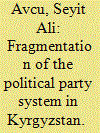

|
|
|
|
|
| Publication |
2013.
|
| Summary/Abstract |
A political party system is the nature and relations of the political parties in a given political system. There are four main variables in the classification of party systems: the extent to which parties penetrate society, the ideologies of the parties, the stance of the parties toward the legitimacy of the regime, and the number of parties in the system. The number of parties determines the level of fragmentation of the party system. Kyrgyzstan emerged as an independent country after the collapse of the Soviet Union. After two revolutions, which resulted in the ousting of the presidents, Kyrgyzstan officially changed its political system by announcing the introduction of parliamentary democracy and held its first elections after the regime change in October 2010. Five parties were able to pass the 5% national threshold to gain seats in the parliament. However, no single party gained enough of a majority to form the government on its own. Therefore, they formed coalitions, the latest of which includes three parties-the SDPK, Ar-Namys, and Ata-Meken-while the other two remained in the opposition: Respublika and Ata-Jurt. I estimated the effective number of parties by votes and seats and the least squares index for the 2010 parliamentary elections using Michael Gallagher's index, which utilizes the Laakso-Taagepera formula. The effective number of parties' index in Kyrgyzstan in terms of seat distribution in the Jogorku Kenesh was 4.90 for the 2010 parliamentary elections. However, the effective number of parties' index in terms of votes received by the parties is much higher: 9.86. On the other hand, the least squares index, which measures the disproportionality of the election results, is 13.75, which indicates the existence of many small parties with no seats. The 5% national threshold played a role in this disproportionality. The thesis of this article is that Kyrgyzstan's political party system is highly fragmented, and both institutional factors, such as constitutional and political party laws and the electoral system, and structural factors, such as social and political cleavages, play a role in this fragmentation.
|
|
|
|
|
|
|
|
|
|
|
|
|
|
|
|
| 19 |
ID:
134311
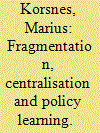

|
|
|
|
|
| Summary/Abstract |
This paper seeks to understand what government mechanisms have allowed China’s wind industry to grow as fast as it has over the past ten years. Instead of formal rules and regulations, this paper focuses on specific sets of institutional conditions that have been crucial in the process of high-speed implementation of wind energy in China. Specifically, fragmentation and centralisation, together with policy experimentation and policy learning, have been fundamental for policy flexibility and institutional adaptability. The paper illustrates that there are benefits and disadvantages to these characteristics, and that inherent qualities of China’s governing system that lead to rapid growth overlap with those that lead to challenges in terms of quality and long-term performance.
|
|
|
|
|
|
|
|
|
|
|
|
|
|
|
|
| 20 |
ID:
166669
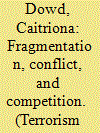

|
|
|
|
|
| Summary/Abstract |
In spite of the shared high profile of recent Islamist attacks on civilians in sub-Saharan Africa, patterns of anti-civilian violence differ across and within violent Islamist groups, and the countries in which they are active. This research seeks to explain this variation by situating Islamist violence within the sub-national spaces in which such groups operate, and the wider conflict environment in which they choose to use, or limit the use of, anti-civilian violence. Drawing on data from the Armed Conflict Location & Event Dataset, the research finds that violent Islamist groups are more likely to target civilians where they are the most active conflict agent, even when other conflict agents are active in the same spaces; but less likely to do so when they are relatively weak and in competition with other non-state armed groups. Anti-civilian violence is thus deployed strategically by violent Islamist groups, while its function as a signalling or retributive policing tool depends on the relative strength of groups in relation to actors in the wider conflict arena.
|
|
|
|
|
|
|
|
|
|
|
|
|
|
|
|
|
|
|
|
|